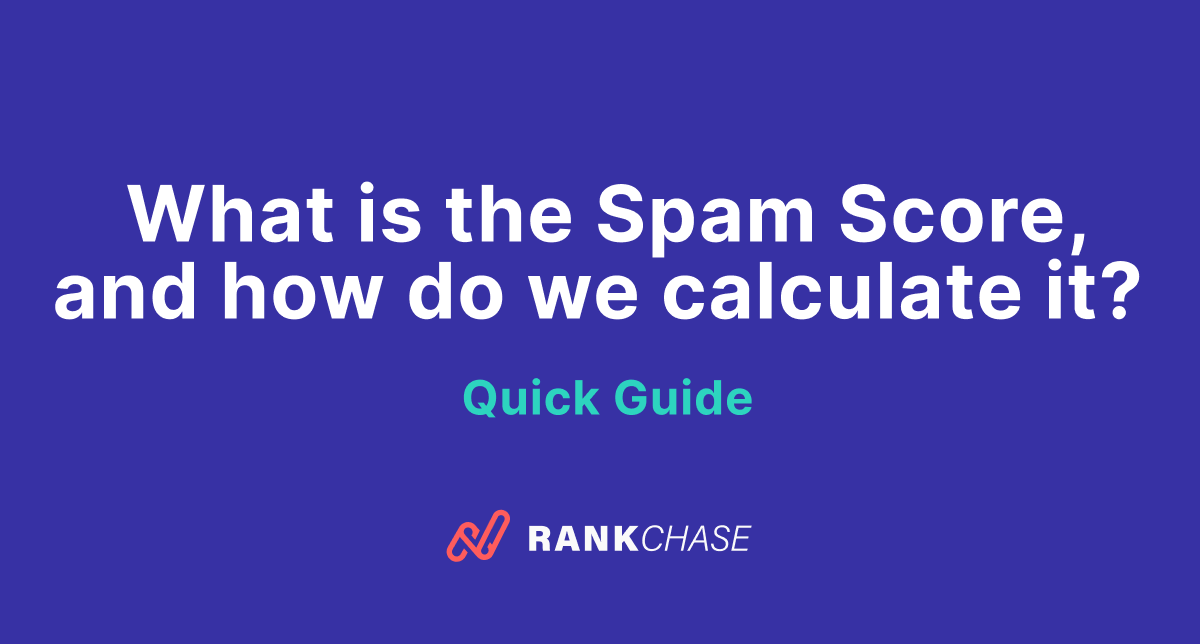BLOG ARTICLE
What is the Spam Score, and how do we calculate it?
Last updated: 4/13/2025
Last updated: 4/13/2025
If you're building backlinks or trying to assess the legitimacy of a website, you've probably come across the term Spam Score.
But what does it actually mean? In simple terms, Spam Score is a percentage-based metric that evaluates how likely a website or page is to be associated with spammy practices. It’s a way to gauge a site’s trustworthiness and is particularly helpful for SEO professionals, marketers, and business owners.

Spam Score ranges from 0% to 100%, and here's a quick breakdown:
- 0–30% (Low): The site is likely trustworthy with minimal spam signals.
- 31–60% (Medium): The site might have some spammy indicators but isn’t necessarily bad.
- 61–100% (High): The site has significant spammy traits and should be reviewed carefully.
While Spam Score is a great indicator, it’s important to remember that it’s just that: an indicator. A high score doesn’t always mean a website is bad—it simply suggests it might require closer inspection.
Why Spam Score Is Important
Spam Score helps you make smarter decisions, especially in the world of SEO. For example:
- SEO Agencies can use it to ensure their clients’ backlinks come from reputable sources.
- Website Owners can identify and fix spammy traits on their own site to improve their credibility.
- Marketers can target high-quality domains for partnerships and avoid sites that might harm their brand reputation.
Understanding a site’s Spam Score, is important to ensure your link-building strategy focuses on quality, not quantity, and avoid potential penalties from search engines.
How We Calculate Spam Score
Our Spam Score is calculated using a combination of 18 specific signals that assess the “spamminess” of a website. Here’s a breakdown of how each signal impacts the score:
Domain and URL Factors
-
Domain name length: If the domain name is shorter than 3 characters, exactly 3 characters, or longer than 20, it adds +10%.
-
Numeric characters in the domain or subdomain:
- If the main domain has 2 or more numeric characters, it adds +15%.
- If the subdomain has 2 or more numeric characters, it adds +20%.
-
Spammy TLDs: Certain top-level domains (e.g.,
.biz,.xyz,.pw) add +20% due to their association with spam.
Page Content and Metadata
- Missing trusted link or script tags: If a page doesn’t contain link or script tags from sources like Google, Bing, or Facebook, it adds +20%.
- Presence of trusted tags: Pages with trusted link or script tags inside the head element reduce the score by -5% (per source).
- Social meta tags: Having social meta tags (e.g., Open Graph or Twitter cards) reduces the score by -15%.
- Contact information: Pages with visible contact info reduce the score by -20%.
- Rel canonical tag: If the page uses a non-local rel canonical tag, it adds +20%.
Technical and Security Signals
- HTTP instead of HTTPS: If the website uses HTTP instead of HTTPS, it adds +30%.
- Title tag: Missing or poorly formatted title tags add +5%, while a properly formatted title tag reduces the score by -5%.
- Description tag: Missing or poorly formatted description tags add +5%, while properly formatted ones reduce the score by -5%.
Linking Patterns
- Meta keywords tag: Pages with more than 10 keywords in the meta keywords tag add +15%.
- External links: Pages with more than 100 external links add +20%.
- Internal links: Pages with more than 500 internal links add +15%.
- External-to-internal link ratio: If the ratio of external to internal links exceeds 3, it adds +15%.
Spammy Top-Level Domains (TLDs)
Certain TLDs are more commonly associated with spam. For example:
.xyz, .biz, .pw, .top, .ga, .ml, .icu, and shorteners like bit.ly are flagged because they’re often used for low-quality or spammy websites. A domain using these TLDs may have +20% added to its Spam Score.
Combining Spam Score with Domain Rank for a Holistic Evaluation
Spam Score is great at spotting potential red flags, like unhealthy backlink profiles or a messy domain structure.
But relying on it alone might mean missing out on valuable opportunities, especially if a site has strong authority despite a few risk factors.
That’s why combining Spam Score with Domain Rank is so important. Domain Rank looks at how trustworthy and influential a site is by analyzing its backlink profile.
When you pair it with Spam Score, you get the best of both worlds: the ability to spot risks and identify high-quality, credible sites, balancing caution with opportunity.
How RankChase Supports Balanced Assessments
RankChase makes it easy to evaluate websites for link and content exchanges by offering both Spam Score and Domain Rank together. Here’s how it helps you:
- Avoid Risks: Check the Spam Score to identify and steer clear of domains with a high likelihood of engaging in spammy practices.
- Maximize Opportunities: Use Domain Rank to identify high-authority sites with strong SEO potential, while double-checking their trustworthiness with Spam Score.
- Build Reliable Partnerships: Focus on sites that are not just authoritative but also safe, ensuring your link-building and outreach efforts are solid and sustainable.
By combining these two metrics, RankChase gives you a clearer picture of website quality, helping you make smarter, more confident decisions for SEO, link-building, and content collaborations.

Final Thoughts
Spam Score is a powerful tool for evaluating a website's credibility, especially when planning your link-building or link-exchange strategy. By analyzing 18 specific signals, it helps you identify potential risks and avoid sites that could harm your SEO efforts.
However, it’s just one part of the puzzle. Pairing Spam Score with Domain Rank gives you a clearer picture of a site’s authority and trustworthiness.
When you combine Spam Score to flag risks with Domain Rank to measure a site’s influence, you can make smarter, data-driven decisions about where to build links or pursue exchanges.